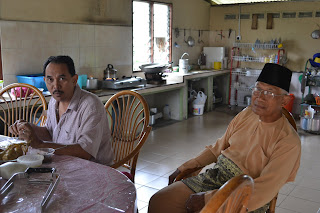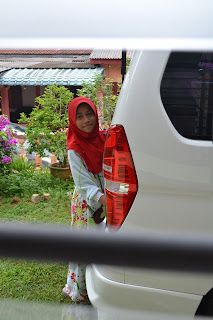Salam
Ramadhan has almost ended. it feels too short. especially because this time around I had to spend the first week of ramadhan in Ampang, the next two weeks in Temerloh, and the remaining week in Ampang again. Phew, that's a lot of traveling! May there will be a next year for us all.
Now, back to the topic. the first time I drove a car to go to the campus in Ampang was waaay back during my first year. It was an old dark blue Honda car which I parked at the roofed parking lot labeled USIM in Sri Pandan. Well surprisingly, one morning I found a note slipped under the car wiper. It says that I'm not the rightful owner of the parking lot, so I'm supposed to move out my car and park it somewhere else. Haha, veeery funny. I could guess who wrote the note for they left clues of who they are. But, it's kinda embarassing to say that it was written by U*** students because it wasn't a nice note and quite unpleasant to read. Hmm, simply put, it was an impolite note.
I didn't drive a car from the 2nd year until last year, when I started the Community Health Posting.
Then, I got another note from a different person this time, regarding the parking lot AGAIN. This time, it was full of CAPITAL LETTERS and EXCLAMATION MARKS!! What a rude note! The one who wrote the note called me upon learning that I drove the car and said sorry.
Oh, dear! I have done nothing wrong and I have to read these offensive notes?
And then, when I came back from my vacation to start the new semester, the note has been upgraded into a clamp. Yes, this time, my light blue Honda car was clamped (this is a different car than before). That idiot clamped my car because I didn't call him and ask for his permission to park my car there. It seem to me that he didn't make much effort to confirm that the car isn't a student's car as he didn't see the USIM-labeled lanyard that I purposely hang at the interior rear view mirror. Well, maybe part of it was my mistake and I won't mind taking the blame (if it really is mine). Hold on, I'm confused. why should I ask for HIS permission? I believe we paid the same amount of hostel fees. Or did he paid more? And other people have to ask for his permission to park there? Well, if that is really the case, I won't mind paying more.
But the truth is, that parking lot belongs to someone who rarely came home and not ours. So, in reality, he doesn't have any right to clamp my car at all. Well, I guess I have to settle down with the fact since I've paid the office to un-clamp my car already. I though the matter was settled when that fellow sent a stupid SMS blaming me for his mistake. Haha...he's making a fool of himself and we (several friends, a senior, and me) had a very good laugh. We think that's very silly.
Now, the moral of my story is, people who seem kind and nice could actually be quite rude and annoying. Nice, yet rude. I know it is not fair to label people (especially budak sekolah agama) like that. But it's because of the few people who act harshly and seen by the outsiders. Yalah, sebab nila setitik, rosak la susu yang sebelanga tu, kan?
Malaysia memang maju. Tiap-tiap tahun bertambah bilangan pelajar yang berkereta. Aaah, I see...no wonder I always get those notes. The car that I drove is just an old 1989 car, unlike other people who drove brand-new cars, or their parents' luxurious cars.
Sekadar mengingatkan perkara yang mungkin terlepas pandang. It's true that budak-sekolah-agama are just human, but I believe it is their responsibility to act accordingly and not to hope that people would understand them. My story might not be applicable to all, so I'll apologize in advance to the others.
Makanya, sempena Ramadhan yang hampir pergi, saya titipkan sepuluh jari memohon ampun dan maaf atas kekasaran dan kesilapan.




















































